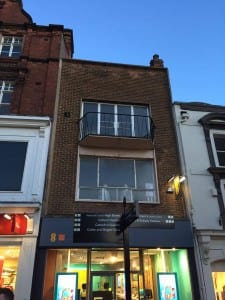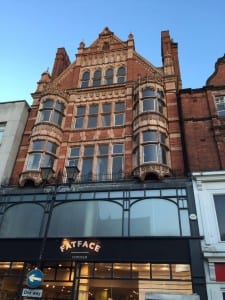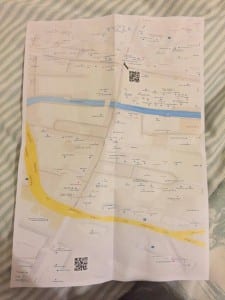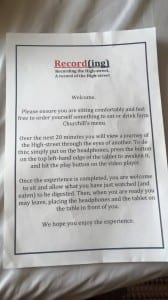Framing Statement
As a group of creative students who were new to Site Specific Performance and the art which it produces, I personally felt apprehensive about how I could create a site specific performance that was both fresh and captivating. It has been a vastly different creative process to anything I have ever worked on before and, at times, it has been incredibly frustrating but now that our performance has been and gone, I feel privileged to have had the opportunity to learn a new art form and study some great creative people along the way.
The overall message our group sought to reflect in our performance was ‘noticing the unnoticed’, which our group constantly embraced throughout the creative process. Georges Perec is a novelist who heavily communicates this through his book An Attempt to Exhaust a Place in Paris (Perec, 1982) in which he, while sat in a public street, states everything that captures his attention, whether it be big or small. Our group read Perec’s book very early on in the process and admired how simple of an action it is to point out the seemingly insignificant details. While reading about and imagining the “… man shaken, but not yet ravaged, by tics…” (Perec, 1982, 19), it instils a sense of curiosity and appreciation for the secret lives being led around you. This effect on the audience was something our group was interested in recreating with our own performance, having felt the effect of it ourselves.
John Smith’s Girl Chewing Gum (Smith, 1976) is another piece of art that similarly identifies the overlooked elements of a busy street yet also incorporated a juxtaposition between the urban street and country field. The way in which Smith makes the audience feel an appreciation for the peacefulness of the country after listening to a busy high street inspired our group to include video into our piece with a seemingly mismatched piece of audio layered over it. For example, the use of Anton Bruckner’s ‘Symphony No. 2’ played over a gentle walk down the Lincoln high street seems slightly amusing for the first few seconds but after a time the video and audio begin to form a connection and guide the audience into discovering a sense of brilliance about the high street.
Our final performance took place in Churchill’s Café on the high street. This café served as a place for the audience members to experience a journey down the high street in a comfortable and calm environment. Assigning Churchill’s as our performance location allowed our group to take a sense of ownership over our performance as this café served as a meeting point for our group to discuss creative ideas throughout the process. We were able to reserve a single seated table which our audience members could book out for half an hour to experience our final creation, a video tour, individually. This enabled the audience members to make their own discoveries on the high street separate from any outside influences.
Analysis of Process
During the second week of our Site Specific module, Steve introduced us to Carl Lavery and his 25 Instructions for Performance in Cities (Lavery, 2005). It was these instructions that served as a foundation for our final performance. As we began to write our own instructions for the high street, I suggested we attempt to personify the buildings by giving each one a particular sound that we think that building would make. This sound would reflect what kind of personality the building has and in turn we would bring the high street alive. In the third week, we furthered this process by assigning even larger profiles to the buildings including job, marital status and my personal favourite, health. Here is an example of two buildings that had completely opposite profiles:


While we did not go on to use these profiles in our final performance or even take them past week third week, it was these experiments that led us to start looking closer at the buildings along the high street. We began to photograph the buildings closer, picking out insignificant elements that are so often overlooked. These ranged from something as small as a crack in the wall, to something as large as a section of new bricks where a window once was.
John Smith’s Girl Chewing Gum (Smith, 1976) was something that our group greatly admired for its ability to entertain, intrigue and confuse the audience simultaneously. It is clear to see the impact he had throughout our creative process as he ‘directs’ the most insignificant actions and in turn magnifies the most intricate details of this street. The juxtaposition of the sound of the field over the video of the street was also a creative element that we found gave a new wave of creative energy to the piece by mixing an urban setting with the sounds of the country. This is reflected in our own final performance as we have the busy yet anti-climactic Lincoln high street against the audio of a grand symphony.
When trying to think how we could further our idea, particularly the format of our performance and how we were going to deliver it to the audience, we started to look at artists such as Marcia Farquhar. Her creation of a live art tour appealed to us because it seemed like such a simple idea from an audience point of view yet you were able to tell the amount of work that had gone on behind the scenes. Blast Theory are another group of artists who influenced our work with the way in which they utilise technology. Their use of mobile phones in A Machine to See With (2010) subverted the audience member’s everyday life by utilising an object they are completely familiar with and turning it into a novel means to convey their narrative. This use of technology was something our group wished to incorporate into our own performance because it is such a modern element. We felt that if we were to create a tour of the Lincoln high street which the audience members knew so well, we would rather them experience it in an unfamiliar way in order to make the high street a place of exploration for them again. In the same week, a member of our group stated how easy it was to make your own QR codes online and scan them using a downloadable app on a smartphone. We were able to create individual QR codes which, when scanned with their smartphone, linked the user to the URL which we assigned to that code. The use of QR codes as a means to deliver content now enabled us to step away from being physically in the piece, just as Blast Theory are physically absent in A Machine to See With (2010) and the audience could feel like the whole experience and interactions were just between them and the locations.
Being set on the idea of creating a tour delivered through QR codes, we set about the high street in search of different locations that we felt had certain effects on people, such as passing under the Stonebow arch, yet still had elements about it that were often overlooked. We managed to gather four locations for our tour to start with, they were:
- The Stonebow arch
- Peter’s Passage
- Opposite High Bridge café
- The car park behind British Heart Foundation
As we enjoyed the use of audio in Girl Chewing Gum (Smith, 1976), we came to the decision that our QR codes would link the audience members to an audio track that revolved around that particular location. Instead of having us ‘direct’ the location as Smith does, we proceeded to interview members of the public who were passing near, or through, our locations. We designed these questions in order to get appropriate responses from the public that we could then overlay together. Questions such as what is the most insignificant thing about this place and if something significant were to happen to you here, what would it be? By only using their responses to the questions, we hoped to create a short audio track which would confuse the listeners as to what the significance of these words meant while still encouraging them to make connections with the space. I specifically wanted to ask the public that ‘If this building could make a noise, what would it be?’ as it related back to our initial experiments in Site Specific. This also proved useful for our audio tracks as we were able to elongate the noises underneath the other responses to give it almost a musical aspect.
We now began to collect ‘artefacts’ from the locations that we could possibly include into our audio tracks. The artefacts consisted of Dames Don’t Care, a book by Peter Cheyney, hand-written instructions on how to drive a car and Anton Bruckner’s ‘Symphony No. 2’. Although we knew these items would become greatly beneficial in our attempt to channel the energy of these locations, we were not yet certain of how to incorporate them.
Just before we were due to showcase our creations to the rest of the group, we designed this map that would lead our audience members around the tour:
This was still in the very early stages of development and so we only included two locations on the map. However, we hoped that by splitting the rest of the group up into two and sending them off separately, it would be clear that we wanted our final audience to explore the map by themselves and experience our performance as an individual. At the end of our performance, we found it difficult to properly gather constructive critisism as, even though the group were split into two, there was still about 8 members in each group and so they were not able to experience our performance the way we would have hoped. As you can see in this video, most of them are paired together:
After numerous discussions on how we could bridge the gap between each location on the map, we started to look at works by Janet Cardiff, most specifically her Alter Bahnhof Video Walk (2012). Including video was not something we had taken into account until now and so the next two weeks saw our performance change rapidly. We experimented by creating our own videos similar to Cardiff and while we knew we would not necessarily be using these videos in our tour, it had a largely positive impact on us as creators. We now knew that a visual aspect in our performance would be key in portraying the high street in a way the audience had never seen before. The following week, we came away from a meeting with Conan with some great feedback and a push in the right (albeit different) direction.
Conan suggested we film one 20-minute video tour down the high street and that we have our audience members watch this video in a comfortable environment rather than having to wander around outside on public paths. Churchill’s Café street had been a place of discussion for our group throughout the previous weeks and so it seemed only fitting to have our tour start and end there. Our group was able to take advantage of the great equipment Josh’s father had in order to keep the video looking professional. We managed to film from Churchill’s all the way down to the car park behind the British Heart Foundation and back again using a steady-cam. Over this video, we included sounds we had recorded along the high street that had been cleverly warped to sound abnormal so the audience were able to experience the everyday sounds of the high street on a whole new level of creativity. This when our ‘artefacts’ from earlier on in the process showed their true worth. We recorded ourselves speaking extracts from the book and the car instructions and then warped them to instil a sense of uneasiness into the listeners, a feeling the audience would not usually feel when walking down their city’s high street. The symphony was, in my eyes, a blessing for our piece. The grandeur of the orchestra against our typical high street echoed our early inspirations from Girl Chewing Gum (Smith, 1976).
After our piece was created, we began to book individual time slots for audience members to experience our video in the comfort yet isolation of a single seated table in a quiet café. We arranged a Samsung tablet to be left on the table with the video on and some headphones with this information sheet:
Performance Evaluation
Our final performance took place on Friday 6th May and continued from 10:30am to 4:00pm. Our group arrived at Churchill’s café just after 9am in order to have a quick informal briefing with the waitresses and set up the video on Jay’s tablet. All members of the group then sat quietly on the first floor of the café so we were out of sight of the audience members and ordered a full English breakfast, a very good start to performance day.
Over the course of the day, there were six audience members that came and viewed our video tour. We were all a little disheartened by the lack of people who came to view our performance although just six audience members still took up 3 hours of the day so we were not able to have more than 4 or 5 other people anyway. I personally think the lack of viewers was because it was an individual performance that lasted half an hour and audience members tend to be more comfortable approaching a performance with a partner or in a group. Our performance was not necessarily experienced by our examiners exactly as we had hoped due to timing issues. Steve and Conan were scheduled to mark other Site Specific performances throughout the day and so originally gave a half an hour slot to preview our performance. With our individual slots being half an hour long, it would have taken an hour for both Conan and Steve to experience our performance as we wished. Due to their schedule, Conan had to view the 20-minute video then immediately wait for Steve in the cafe as he proceeded to watch the video rather than leaving the café entirely after a few more minutes. While this was not a major set-back for us and we had to take into account the other performances on that day, it was not entirely how we wanted the examiners to experience our performance.
An element to our final performance that we were not able to anticipate until performance day was the sounds and ambience of the café breaking through the headphones and into our audience’s ears while watching the video. We created the audio assuming that these would be the only sounds the audience would hear but after testing it on ourselves with the noise of the café, it actually enhanced the experience. The café also touched on the other senses of audience members. For example, when the video reaches a busy road and you expect to smell car fuel, you instead smell coffee beans and toast. While we initially wanted the audience to be taken away and transported through the video tour, these elements brought a new sense of authenticity to our whole performance.
If I were to create this performance again, I would perhaps think of a way audience members could enter the performance in a group yet still view the video individually as I feel the isolation from other people was key to the experience. Overall, while I struggled to come to terms with creating a performance in a non-traditional venue, my research and experiments throughout the creative process has enriched my understanding of Site Specific and the influence it can have on an audience.
Works Cited
Lavery, C. (2005) Teaching Performance Studies: 25 Instructions for Performance in Cities. Studies in Theatre and Performance, 25 (3) 229-238.
Perec, G. (1982) An Attempt at Exhausting a Place in Paris. Cambridge: Wakefield Press.
Smith, J. (dir.) (1976) Girl Chewing Gum. [film] London: Royal College of Art.
Blast Theory. (2010) A Machine to See With. [performance art] Canada: Banff New Media Institute.
Cardiff, J and Miller, G. (2012) Alter Bahnhof Video Walk. [performance art] Germany: Kassel Train Station.

